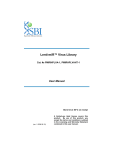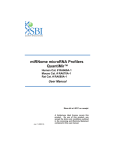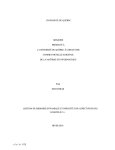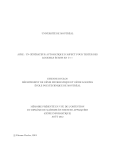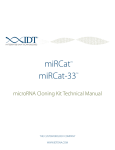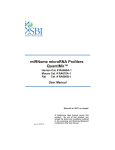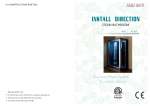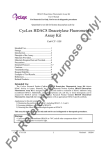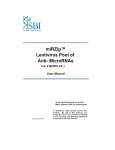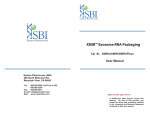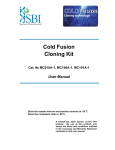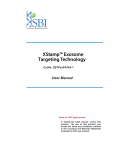Download MicroRNA Target Selection System User Manual
Transcript
miR-Selection 3’UTR Target Selection Kit Cat. # MS040-4xxA-1 User Manual Store kit at -20°C upon receipt A limited-use label license covers this product. By use of this product, you accept the terms and conditions outlined in the Licensing and Warranty Statement contained in this user manual. microRNA Target Selection Kit Cat. # MS040-4xxA-1 Contents I. Introduction and Background A. OVERVIEW B. THE MICRORNA TARGET SELECTION SYSTEM VECTOR C. HOW THE MICRORNA TARGET SELECTION SYSTEM WORKS D. LIST OF COMPONENTS E. ADDITIONAL REQUIRED MATERIALS 2 3 4 4 4 II. Protocol A. B. C. D. E. F. CLONE 3’ UTR OF INTEREST IN MIR-SELECTION VECTOR VIRAL PACKAGING AND STABLE CELL LINE CREATION TESTING MICRORNA CANDIDATES THE CYTOTOXIC SCREEN RECOVERY OF THE EFFECTOR MICRORNAS THE FIREFLY LUCIFERASE ASSAYS 5 5 6 6 6 8 III. Quality Control and Sample Data A. THE EF1-PUROMYCIN CASSETTE B. THE LUCIFERASE ASSAY C. THE CYTOTOXIC CTX KILL CURVE D. VALIDATION OF THE MICRORNA SELECTION SYSTEM 8 8 9 9 IV. Troubleshooting 10 V. References 11 VI. Appendix A. Related Products B. Technical Support 11 12 VII. Licensing and Warranty Statement 888-266-5066 (Toll Free) 650-968-2200 (outside US) 13 Page 1 System Biosciences (SBI) User Manual I. Introduction and Background A. OVERVIEW This manual provides details and information necessary to use the microRNA Target Selection Kit to detect the successful and productive binding events between gene mRNA 3’UTRs and microRNAs. To ensure optimal results, please read the entire manual before using the reagents and materials supplied with this kit. SIGNIFICANCE OF IDENTIFYING MICRORNA TARGET INTERACTIONS MicroRNAs are a major class of small non coding RNAs that act as endogenous repressors of target gene expression. After the seminal discovery of Lin-4 and let-7 microRNAs in C. elegans in 1993[1], over ten thousand microRNAs have been discovered in various species. The importance of microRNAs in multiple cellular pathways and the roles they play in human diseases, such as cancer, neurological and immune diseases are becoming increasingly appreciated [2-6]. MicroRNAs target the 3’ Untranslated Regions (UTRs) of messenger RNAs and suppress their protein expression either by translation inhibition or deadenylating the mRNA for ultimate degradation [7]. A single microRNA can regulate several hundred target genes in a complex regulatory mechanism. In order to gain insights and understanding of microRNA regulatory circuitry, it is important to identify their cellular targets. However, imperfect base pairing of microRNAs to target RNAs results in inaccurate predictions[8-10]. The prediction algorithms also yield large numbers of putative microRNA-targeted genes, thus making the choices unmanageable for researchers to choose which ones to pursue. Other cell-based experimental approaches using reporters (like luciferase only) to verify each of these predicted interactions are laborious and time-consuming, often leading to unproductive results. There exists a significant gap between the number of predicted microRNA targets and the number of experimentally validated targets. Thus, target validation is a crucial bottleneck in the efforts of researchers in the microRNA field to dissect microRNA pathways. Page 2 ver. 0526-2010 www.systembio.com microRNA Target Selection Kit Cat. # MS040-4xxA-1 B. THE MICRORNA TARGET SELECTION SYSTEM VECTOR The miR-Selection lentivector features a dual reporter system with firefly luciferase (Fire) and a cytotoxic sensor (Ctx). The miR-Selection platform captures the 3’ UTR to microRNA binding event using a survival screen by modulating the reduction of the cytotoxic sensor. Quantitative validation is made simple using the built-in luciferase reporter. This powerful and elegant technology finally enables the accurate identification of microRNA targets and enables high-throughput target identification screens. The miR-Selection lentivector features an EF1-Puro cassette to create stable cell lines for screening (orange in vector map). The 3’ UTR under study is cloned into the Multiple Cloning Site (MCS) where it influences the expression of the upstream Firefly Luciferase (Fire) and the Cytotoxic sensor (Ctx) genes. The microRNA target selection technology is in SBI’s third generation Lentivector backbone. This lentivector backbone allows this construct to be packaged into high titer pseudoviral particles and introduced into hard to infect cell lines to generate a stable cell line or even utilized in animal models. Additional features in this vector include an EF1-Puromycin cassette that enables the simple generation of a homogenous cell line and a convenient Multiple Cloning Site (MCS) where your 3’UTR of interest can be inserted. SBI’s lentiviral transduction system is replication incompetent and hence it is biologically safe. 888-266-5066 (Toll Free) 650-968-2200 (outside US) Page 3 System Biosciences (SBI) User Manual C. HOW THE MICRORNA TARGET SELECTION SYSTEM WORKS The cytotoxic screening assay is a unique approach where multiple microRNA binding targets within the 3’UTR of interest can be easily identified in a single experiment. In this assay, the cytotoxic sensor is constitutively expressed via a CMV promoter and its expression becomes lethal to the cell when the cytotoxic drug (Ctx) is added to the medium. In a screen where multiple microRNAs are overexpressed, only the cells expressing those microRNAs that interact with the 3’UTR, and thus down-regulate the sensors, will survive the drug selection. These effectors microRNAs can be easily identified by PCR analysis from those surviving cells genomic DNA. Dual Sensor technology The dual sensors for Luciferase and Ctx are under the direct expression control of the 3’UTR inserted behind the markers. Addition of one or more microRNAs in combination with supplying the Ctx drug to cell culture media begins the selection screen. If there is no binding site in the 3’ UTR clone for the microRNA being tested, the cells do not survive the selection (skull and bones) but will thrive if microRNAs bind to the 3’ UTR in the construct (happy face). Quantitative validation is made simple using the built-in luciferase reporter. D. LIST OF COMPONENTS Each microRNA target selection Kit contains: Amount 10 μg microRNA Selection Lentivector plasmid (uncut) 1 tube 1000 μl Component 1000X concentration Ctx drug powder (resuspend in 1000μl Ctx resuspension buffer) Ctx resuspension buffer IMPORTANT: Resuspend the Ctx drug with 1000 μl Ctx resuspension buffer and then aliquot into 10 tubes of 100 μl for storage at –20°C (stable for 3 months, avoid repeated freeze-thaws of Ctx drug after resuspension). NOTE: If precipitates from in the Ctx drug suspension, warm the solution at +37°C for 5-10 minutes and vortex to mix. E. Additional Required Materials Thermocycler (with heated lid) Thermocycler PCR tubes or plates for end-point reactions PCR Mastermix, including Taq polymerase for PCR 3.0-3.5% Agarose Gel in Tris-Borate EDTA (TBE) or Tris-Acetate EDTA (TAE) Buffer DNA Size Ladder with markers from 50 to 2,000 bp (Bio-Rad AmpliSize™ DNA Ladder; Cat. # 170-8200) Cell culture media, incubator and hood for 293 cells Page 4 ver. 0526-2010 www.systembio.com microRNA Target Selection Kit Cat. # MS040-4xxA-1 II. Protocol A. Clone 3’ UTR of interest in miR-Selection Vector Downstream of the dual reporter in the microRNA Selection vector contains a convenient multiple cloning site (MCS) where the 3’ UTR of interest can be cloned. If the users cannot use any of the enzymes from the multiple cloning sites, they can take advantage of SBI’s Cold Fusion kit Cat # MC101A-1. The Cold Fusion kit employs an efficient and simple enzyme free method of cloning. Once the 3’ UTR has been cloned, the sequence can be verified using the EF1 reverse primer: EF1 rev primer 5’CAACTTCTCGGGGACTGTGGGC-3’ B. Viral Packaging and stable cell line creation The 3’ UTR miR-Selection construct and the miR-Selection vector empty control can be packaged into pseudoviral particles using SBI’s LentiStarter kit (Cat # LV050A-1). Using the same kit, the viral particles can be transduced into desired cell type. Three days after viral transduction, the cells need to be split 1:2 and puromycin at the concentration of 1g/ml should be added to the cells. After three days, the cells should be split again and fresh puromycin should be added at a concentration of 1g/ml. After two additional days under puromycin selection, fresh media should be added to the cells and allowed to recover for two to three days. At this point, the cells are stably expressing the desired constructs and cells can be expanded and frozen for later use. For 6 freezing cells, 2x10 cells should be washed with 1xPBS and resuspended in a mixture of FBS with 1 % DMSO and frozen at – 80°C. 888-266-5066 (Toll Free) 650-968-2200 (outside US) Page 5 System Biosciences (SBI) User Manual C. TESTING MICRORNA CANDIDATES Transduction of microRNA or a microRNA pooled virus library SBI has the largest collection of microRNA precursor clones that are in lentiviral backbone and they co-expresses GFP. SBI also has pooled microRNA libraries (Cat # PMIRHPLVA-1, PMIRHOPLVA-1). SBI can also custom build a desired pool of microRNA viral or plasmid library. These clones can be used to transduce the stable cell lines generated previously. Three days after transduction, the cell lines can be split and are ready for the cytotoxic screen. We do not recommend Transfection of microRNAs due to the 4-6 day duration of the Ctx screen. D. THE CYTOTOXIC SCREEN For the cytotoxic screen, please follow the schedule outlined below: Day 1: We recommend that the user seed the control cells (miR Selection empty vector) and the 3’ UTR construct cells at a density of 80,000 cells /well of in a six well plate in triplicates Day 2: Add the Ctx drug to the medium at a dilution of 1:1000 in one well and 1:1500 in another well and not add any drug in a well Day 4: Change media and add fresh drug Day 5: Remove media, and wash the cells three to four times with PBS and add more fresh media without Ctx drug Day 10: Harvest the cells to identify the effector microRNAs E. RECOVERY OF THE EFFECTOR MICRORNAS Materials required and not supplied in kit: For Purification of genomic DNA • DNeasy Tissue Kit (QIAGEN, Cat. # 69504 or equivalent) For PCR Amplification • Standard PCR kit (TITANIUM Taq PCR Kit, Clontech Cat# 639210 or equivalent) • Thermal Cycler (DNA Engine, MJ Research, Cat. # PTC-200 or equivalent) • 2.5% 1X TAE Agarose gel 1. Purify Genomic DNA from Selected Cells from SBI’s Lenti-miR Phenotypic Screen Prepare genomic DNA from selected cells according to manufacturer’s recommendations. Measure the yield of DNA by spectrophotometer. You should expect to isolate 5-10 μg of genomic DNA from approximately 1×106 cells. Dilute the DNA sample in deionized water to a concentration of 0.2 μg/μl. 2. A sample PCR reaction for SBI microRNA effector clone sequence amplification is provided below. A. Prepare a PCR Master Mix for all reaction tubes, plus one Page 6 ver. 0526-2010 www.systembio.com microRNA Target Selection Kit Cat. # MS040-4xxA-1 additional tube. Combine the following components in the order shown: 41 μl Deionized H2O 5 μl 10X PCR buffer 1 μl 50X dNTP mix (10 mM of each dNTP) 1 μl LVL Primer Mix (SBI, 10 μM of each primer) 1 μl Purified Genomic DNA (~200ng) 1 μl 50X Taq DNA polymerase 50 μl Total volume Note: Include no DNA negative control. B. Mix contents by vortexing, and spin the tube briefly in a microcentrifuge. C. Perform PCR amplification according to these guidelines: • 94°C for 2 min • (94°C for 30 sec; 60°C for 30 sec) for 25 cycles • 68°C for 1 min • 15°C hold D. When the program is completed, analyze a 10-μl sample from each tube and suitable DNA size marker (200 bp-2 kb) on a 1.5% agarose/EtBr gel in 1X TAE. Note that each microRNA precursor clone within the library collection varies in length. Therefore the expected amplicon size may range from 500 to 600bp. 888-266-5066 (Toll Free) 650-968-2200 (outside US) Page 7 System Biosciences (SBI) User Manual F. THE FIREFLY LUCIFERASE ASSAYS We recommend using Promega’s Luciferase assay system, catalog #E1501 to detect changes in Luciferase expression from the miR-Selection lentivector. III. QUALITY CONTROL AND SAMPLE DATA A. THE EF1-PUROMYCIN CASSETTE 293 Cells transduced with psuedoviral particle containing the microRNA selection vector were seeded at 80,000 cells per well. Puromycin was added to a concentration of 1 mg/ml. Seven days after selection; more than 60% of the cells survived the puromycin selection, compared to the 293 cells alone where none of the cells survived the selection. B. THE LUCIFERASE ASSAY Stable cell lines expressing the microRNA selection cassette and control 293 cells was tested for Luciferase activity (Promega). The luciferase assay was performed according to the manufacturer’s recommendation. As shown in Figure cell line expressing microRNA selection cassette showed robust Luciferase activity. This ensures that the luciferase gene in the vector is highly functional. Page 8 ver. 0526-2010 www.systembio.com microRNA Target Selection Kit Cat. # MS040-4xxA-1 C. THE CYTOTOXIC CTX KILL CURVE Stable cell lines expressing the microRNA selection cassette was seeded at 80,000 cells per well in a six well plate. Next day drug was added with 1000x dilution. Cells were harvested on Day 0, day 2 Day 4 and Day 8. Cells were counting using a hemocytometer. Trypan blue was added to ensure counting of only the surviving cells. Representative phase contrast images shown below are 293 control cells and 293 cells transduced with the miR-Selection vector treated -/+ Ctx drug. As shown in the figure, five days after the drug treatment, only 10% of the cells survive in the 293 cells with miRSelection vector. This ensures that the cytotoxic sensor is expressed and responds to the Ctx drug. D. VALIDATION OF THE MICRORNA SELECTION SYSTEM We cloned 3’UTR of the human c-Myc gene in the miR-Selection vector and transduced it into 293 cells. If microRNAs bind to the 3’ UTR being tested, then the expression levels of both luciferase and the Ctx sensors will be greatly reduced. Lowering the amount of the Ctx sensor is what will enable the cells to survive in the presence of the Ctx drug. This interaction between microRNAs and the 3’ UTR is key to the selection system and is what is being measured during the screen. We also measured the luciferase (Fire) activities of the +/- c-Myc 3’ UTR in the miR-Selection vector infected with or without LentimiR-145 virus without Ctx selection[11, 12]. Our results show that the levels of luciferase were unchanged in the No UTR controls as expected and we also observed a 63% reduction in luciferase activity in the c-Myc 3’ UTR plus Lenti-miR-145 cells. We validated the miR-Selection system with known binding partners of miR-145 and the 3’ UTR from c-Myc using both a cellular selection and with luciferase reporter assays. The real power of the technology will be to use it as a discovery tool to identify and validate, without prejudice, microRNAs that can bind and regulate a 3’ UTR of interest. 888-266-5066 (Toll Free) 650-968-2200 (outside US) Page 9 System Biosciences (SBI) User Manual IV. Troubleshooting 1. Poor Infection Efficiency Too high a volume of infecting supernatant Keep the volume as low as possible to achieve maximal adsorption of viral particles to the cells. The assay is carried out too early Normally, the maximal expression of integrated provirus is expected to develop by 48 hours after infection. However, some cells display delayed expression. Try the assay at a later time, such as 72 or 96 hours. Target cell line may be difficult to transduce Optimize the transduction protocol. Use a higher MOI. Wrong amount of Polybrene added during titration Add and optimize Polybrene concentration in the range of 4-10 μg/ml. Loss of pseudoviral titer during storage Store pseudoviral stock at –80°C. Each freeze-thaw cycle drops the titer 2-4 fold. Use a fresh aliquot for transduction. 2. Infection Affects Target Cell Viability High MOI may be toxic to some cell types. Reduce the amounts of virus used. Polybrene is toxic for target cells Optimize the concentration and exposure time to Polybrene during the transduction step. Page 10 ver. 0526-2010 www.systembio.com microRNA Target Selection Kit Cat. # MS040-4xxA-1 V. References 1. Wightman, B., I. Ha, and G. Ruvkun, Posttranscriptional regulation of the heterochronic gene lin-14 by lin-4 mediates temporal pattern formation in C. elegans. Cell, 1993. 75(5): p. 855-62. 2. Kaneda, R. and K. Fukuda, MicroRNA is a new diagnostic and therapeutic target for cardiovascular disease and regenerative medicine. Circ J, 2009. 73(8): p. 1397-8. 3. Hebert, S.S. and B. De Strooper, Alterations of the microRNA network cause neurodegenerative disease. Trends Neurosci, 2009. 32(4): p. 199-206. 4. Min, H. and S. Yoon, Got target? Computational methods for microRNA target prediction and their extension. Exp Mol Med. 42(4): p. 233-44. 5. Du, L. and A. Pertsemlidis, microRNAs and lung cancer: tumors and 22-mers. Cancer Metastasis Rev. 29(1): p. 109-22. 6. Subramanian, S. and C.J. Steer, MicroRNAs as gatekeepers of apoptosis. J Cell Physiol. 223(2): p. 289-98. 7. Denli, A.M., et al., Processing of primary microRNAs by the Microprocessor complex. Nature, 2004. 432(7014): p. 231-5. 8. Yousef, M., L. Showe, and M. Showe, A study of microRNAs in silico and in vivo: bioinformatics approaches to microRNA discovery and target identification. FEBS J, 2009. 276(8): p. 2150-6. 9. Heikham, R. and R. Shankar, Flanking region sequence information to refine microRNA target predictions. J Biosci. 35(1): p. 105-18. 10. Sioud, M. and L. Cekaite, Profiling of miRNA expression and prediction of target genes. Methods Mol Biol. 629: p. 257-71. 11. Sachdeva, M., et al., p53 represses c-Myc through induction of the tumor suppressor miR-145. Proc Natl Acad Sci U S A, 2009. 106(9): p. 3207-12. 12. Sachdeva, M. and Y.Y. Mo, miR-145-mediated suppression of cell growth, invasion and metastasis. Am J Transl Res. 2(2): p. 170-80. VI. Appendix A. Related Products Cancer microRNA qPCR Array (Cat. # RA610A-1) Pre-formatted 96-well plate containing assays for 95 oncomirs and U6 control. 10 complete profiles plus QuantiMir kit included. Stem Cell microRNA qPCR Array (Cat. # RA620A-1) Pre-formatted 96-well plate containing assays for 95 different microRNA invloved in stem cell self-renewal, hematopoiesis, neural development and tissue specificity. Arra also contains U6 control. 10 complete profiles plus QuantiMir kit included. miRNome Profilers (Cat. # RA660A-1 [Human], Cat. # RA670A-1 [Mouse]) Profile all known microRNAs (including minor star* forms) for Human or Mouse. Sanger miRBase 100% updated, 20 complete profiles with QuantiMir kit included. pPACKH1™ Lentivector Packaging Kit (Cat. # LV500A-1) Unique lentiviral vectors that produce all the necessary HIV viral proteins and the VSV-G envelope glycoprotein from vesicular stomatitis virus required to make active pseudoviral particles. q293TN cells (SBI, Cat. # LV900A-1) transiently transfected with the pPACKH1 and a pMIRNA1 microRNA expression construct produce packaged viral particles containing a microRNA construct. 293TN Human Kidney Producer Cell Line (SBI, Cat. # LV900A-1). For packaging of plasmid lentivector constructs. PEG-it™ Virus Precipitation Solution (Cat. # LV810A-1). Simple and highly effective means to concentrate lentiviral vector inocula produced with SBI’s pPACK Lentivector packaging systems. Transdux (Cat. # LV850A-1). Simple and efficient transduction of cells Lentivector UltraRapid Titer PCR Kit (Cat. # LV960A-1 [for human cells], LV960B-1 [for mouse cells]) 888-266-5066 (Toll Free) 650-968-2200 (outside US) Page 11 System Biosciences (SBI) User Manual Allows you to measure copy number (MOI) of integrated lentiviral constructs in genomic DNA of target cells after transduction with constructs made in any of SBI’s FIV or HIV-based Lentivectors QuantiMir small RNA quantitation system (Cat. # RA420A-1) Easily profile miRNAs using a single cDNA synthesis step and realtime qPCR. MicroRNA Precursor Clone collection (cat#s pMIRHxxxPA-1) SBI’s collection of individual microRNA precursor expression clones in lentivectors Lenti-miRs (Cat. # PMIRHxxA-1) Over express microRNA precursors using lentivectors. miRZips (Cat. # MZIPxxA-1) Permanent microRNA knockdown using RNAi lentivectors with anti-sense microRNAs.. B. Technical Support For more information about SBI products and to download manuals in PDF format, please visit our web site: http://www.systembio.com For additional information or technical assistance, please call or email us at: System Biosciences (SBI) 1616 North Shoreline Blvd. Mountain View, CA 94043 Phone: (650) 968-2200 (888) 266-5066 (Toll Free) Fax: (650) 968-2277 E-mail: General Information: [email protected] Technical Support: [email protected] Ordering Information: [email protected] Page 12 ver. 0526-2010 www.systembio.com microRNA Target Selection Kit Cat. # MS040-4xxA-1 VII. Licensing and Warranty Statement Limited Use License Use of the miR-Selection Kit (i.e., the “Product”) is subject to the following terms and conditions. If the terms and conditions are not acceptable, return all components of the Product to System Biosciences (SBI) within 7 calendar days. Purchase and use of any part of the Product constitutes acceptance of the above terms. Purchase of the product does not grant any rights or license for use other than those explicitly listed in this Licensing and Warranty Statement. Use of the Product for any use other than described expressly herein may be covered by patents or subject to rights other than those mentioned. SBI disclaims any and all responsibility for injury or damage which may be caused by the failure of the buyer or any other person to use the Product in accordance with the terms and conditions outlined herein. SBI has pending patent applications related to the Product. For information concerning licenses for commercial use, contact SBI. Limited Warranty SBI warrants that the Product meets the specifications described in the accompanying Product Analysis Certificate. If it is proven to the satisfaction of SBI that the Product fails to meet these specifications, SBI will replace the Product or provide the purchaser with a refund. This limited warranty shall not extend to anyone other than the original purchaser of the Product. Notice of nonconforming products must be made to SBI within 30 days of receipt of the Product. SBI’s liability is expressly limited to replacement of Product or a refund limited to the actual purchase price. SBI’s liability does not extend to any damages arising from use or improper use of the Product, or losses associated with the use of additional materials or reagents. This limited warranty is the sole and exclusive warranty. SBI does not provide any other warranties of any kind, expressed or implied, including the merchantability or fitness of the Product for a particular purpose. SBI is committed to providing our customers with high-quality products. If you should have any questions or concerns about any SBI products, please contact us at (888) 266-5066. © 2010 System Biosciences (SBI). 888-266-5066 (Toll Free) 650-968-2200 (outside US) Page 13















